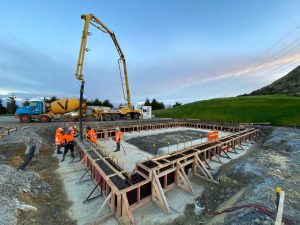Introduction:
At the heart of the Maungaharuru Range in Hawke’s Bay, New Zealand, the Connell team took on an ambitious project – the Harapaki Windfarm. Commissioned by key players in the energy sector, including Meridian Energy, Unison, Transpower, and Omexom, Connell was entrusted with the responsibility of executing the civil and building works for the Harapaki Windfarm Substations. This wind farm stands as a testament to New Zealand’s commitment to a sustainable, renewable future.
Unveiling Harapaki Windfarm:
Harapaki Windfarm is a groundbreaking initiative, positioned to play a pivotal role in New Zealand’s journey towards a Net Zero goal. Comprising 41 turbines, the wind farm has the capacity to generate a whopping 176 MW of renewable energy, effectively powering over 70,000 average households and making it the second-largest wind farm in the country.
Connell’s Role in the Transformation:
From early 2022 until June 2023, the Connell team labored tirelessly on-site, constructing two substations vital to the project’s success – one for Transpower and another for Meridian Energy. The complexity of the task was magnified by the challenging conditions and unforeseen hurdles, including extreme weather fluctuations, a cyclone, and unexpected ground conditions.
Adapting to Challenges:
According to Regional Manager Fabian Bracken, the team faced an array of challenges, from logistical issues to the unpredictability of weather. The region experienced extremes – from beautiful sunshine to snow and gale force winds. Cyclone Gabrielle struck midway through the project, forcing the Connell team to relocate to Taupō for accommodation due to the local community’s hardship.
Prioritizing Health and Safety:
Despite the adversities, Connell’s commitment to health and safety remained unwavering. Rigorous planning, coupled with a focus on providing suitable Personal Protective Equipment (PPE), ensured the team’s well-being. Fabian emphasized the importance of investing in fire-retardant swandries and thermals to combat the harsh conditions while complying with client requirements.
Environmental Responsibility:
The project’s commitment to sustainability extended beyond the construction phase. Accurate records on waste disposal and material usage, including timber, concrete, steel, and aggregate, were meticulously maintained. This approach reflects Connell’s dedication to minimising environmental impact and aligning with the project’s strong focus on sustainability.
Collaboration and Problem-Solving:
The success of the Harapaki Windfarm project hinged on Connell’s ability to collaborate effectively with local contractors. Engaging piling contractors, reinforcing fixings, plumbers, and painters showcased Connell’s adept project management and site leadership skills. Fabian highlighted the importance of bringing together the right people to overcome challenges and deliver a successful outcome for all stakeholders.
Conclusion:
In the face of adversity, Connell has demonstrated resilience and expertise in executing a project of immense significance. The Harapaki Windfarm stands not only as a symbol of New Zealand’s commitment to renewable energy but also as a testament to the industry-leading capabilities of Connell in overcoming challenges and delivering sustainable solutions. As we look towards a cleaner, greener future, projects like these pave the way for a more sustainable and eco-friendly tomorrow.
